We recently published a post all about selling an RV. A reader asked in the comments if we might consider doing a similar article on how to BUY an RV (thanks, Jacques!), so today’s post looks at the steps to take when you’re considering buying a new or used RV. With spring right around the corner, and interested RVers starting to look to buy for the coming season, let’s take a look at how to buy an RV!
- 1) Decide What Type of RV You Want
- 2) Will You Buy New or Used?
- 3) Determine Your Price Range
- 4) How Will You Pay For the RV?
- 5) What Type of Traveling Will You Do?
- 6) Will You Be On the Grid, Off the Grid, Or Both?
- 7) What Features Are Important to You?
- 8) Expenses You Need to Consider
- 9) How to Score the Best Price
- 10) Where to Look for an RV
Decide What Type of RV You Want
First, of course, you need to decide what type of RV you want to buy. This decision will be based on a number of considerations including how many people will be traveling with you, whether you want to travel in a motorhome or tow a travel trailer, what tow/towed vehicle you have or need to buy, and what your travel priorities are.
Let’s take a look at the options:
Class A
A Class A RV is generally the largest type of motorhome. But there are wide variations in the sizes of motorhomes in this category. For example, you could buy a 43-foot diesel pusher like ours (or even larger at up to 45 feet!), or you could opt for one of the more compact Class A rigs similar to those we looked at in our post “5 Awesomely Small Class A Motorhomes”.
Keep in mind that Class A RVs are available in two distinct flavors — gas and diesel, each of which has some specific characteristics that may lead you to only look at one vs the other.
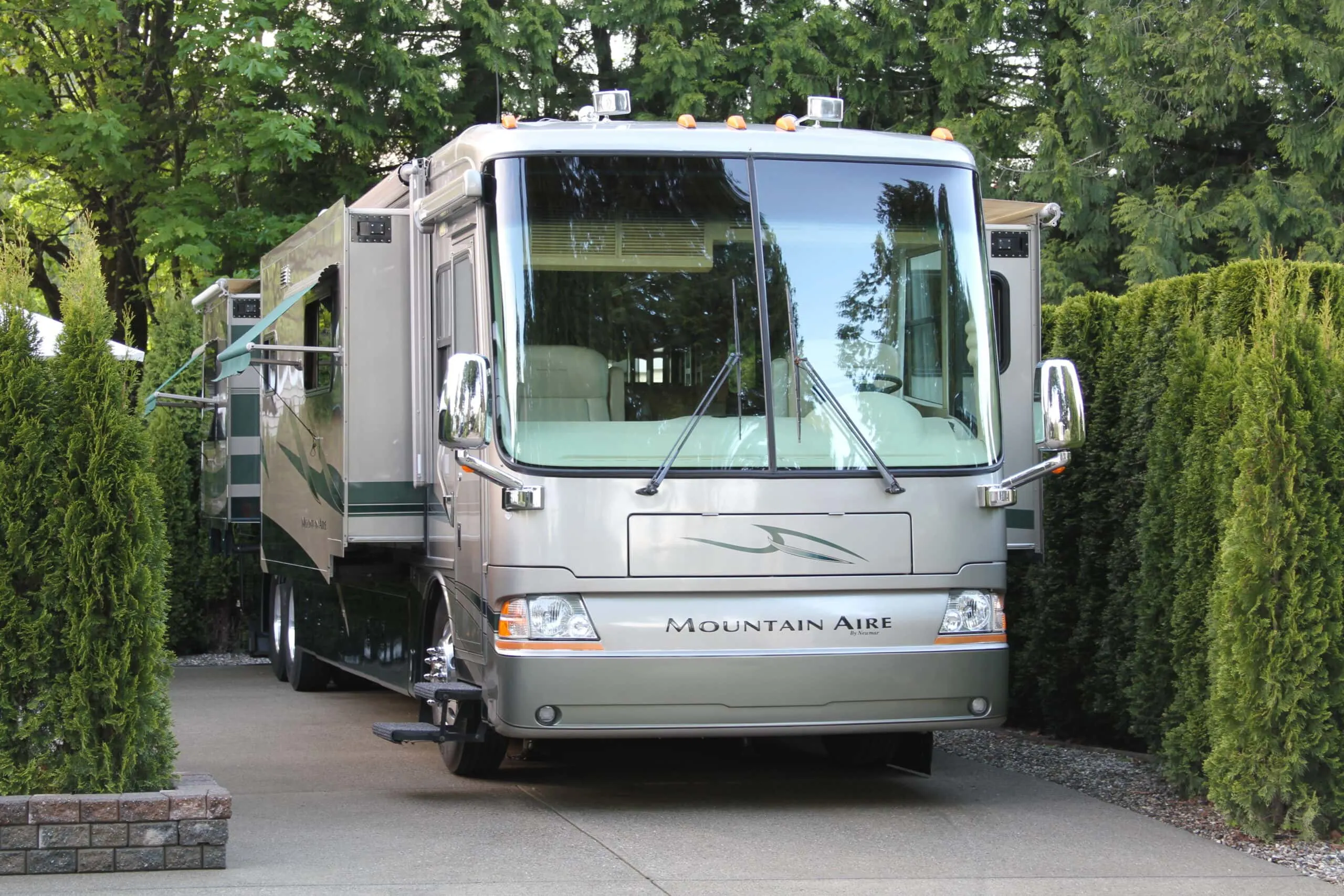
Our RV is a 43-foot Class A diesel pusher.
For those interested in learning more about Class A RVs, please have a look at our article, “What Is a Class A RV” for lots of details.
Remember to consider that Class A rigs are generally (but not always) longer, wider, and taller than other RVs. If you’re considering a Class A RV, pay attention to the fact that you’ll be driving a very large vehicle, and the responsibility of learning how to drive a rig this size properly falls on you. (See our post noting whether or not you need a special Class A license to drive a big rig.)
While the idea of driving a very large RV may not be intimidating to you at all, if you’ve never before driven a rig this size, bear in mind that RVing doesn’t just mean travelling down the interstate/highway. We’ve got to become adept at navigating turns, backing, passing, merging, and of course, getting into campsites in campgrounds and RV parks. There are also additional mirrors to learn how to adjust and use, off-tracking around turns, rear overhang swing, and managing the height of the rig we’re driving.
We suggest having a look at our posts, “How Tall is a Class A Motorhome”, and spending some time with the posts from our Driving School series, “How to Drive an RV: Off-Tracking and Rear Overhang”, and “How to Adjust RV Mirrors & Maintain Lane Control”. These are two of our most important posts and videos for anyone learning to drive a Class A RV, and give you the benefit of learning from a professional big rig driving instructor (Peter). Both articles offer clear photo guidance and videos to illustrate all of this instructional material.
Reading the posts and watching the videos from our RV Driving School series is a great way to familiarize yourself with how to drive a large Class A RV.
You may also wish to have a look at “7 Pro Tips for Backing Up a Motorhome” (these tips are useful no matter what size motorhome you’re considering). If you’re interested in knowing more about the fuel economy associated with Class A rigs, we’ve got you covered there with our post, “What’s the Typical Fuel Economy of a Class A Motorhome?”.
Although we’ve traveled in other types of RVs in the past 20 years, we’ve by far spent the most time traveling and living in a Class A diesel pusher. We shared the benefits of this type of RV in a post entitled, “Benefits of a Diesel Class A Motorhome”.
We’ve even published a post on “The Best Places to Buy a Used Class A RV”, so feel free to visit that post for additional information in this regard.
Class B
While Class B RVs aren’t the smallest RVs on the market, they are the smallest motorhomes. These little rigs are often referred to as “camper vans”, and are easy to drive, simple to park (often in a regular parking space), and lots of fun.
With Class B rigs you’re essentially trading living space for driving convenience and better fuel economy. But, for singles or couples, or even young families with a small child or two, the Class B RV can provide a great way to travel, short-term or long-term.
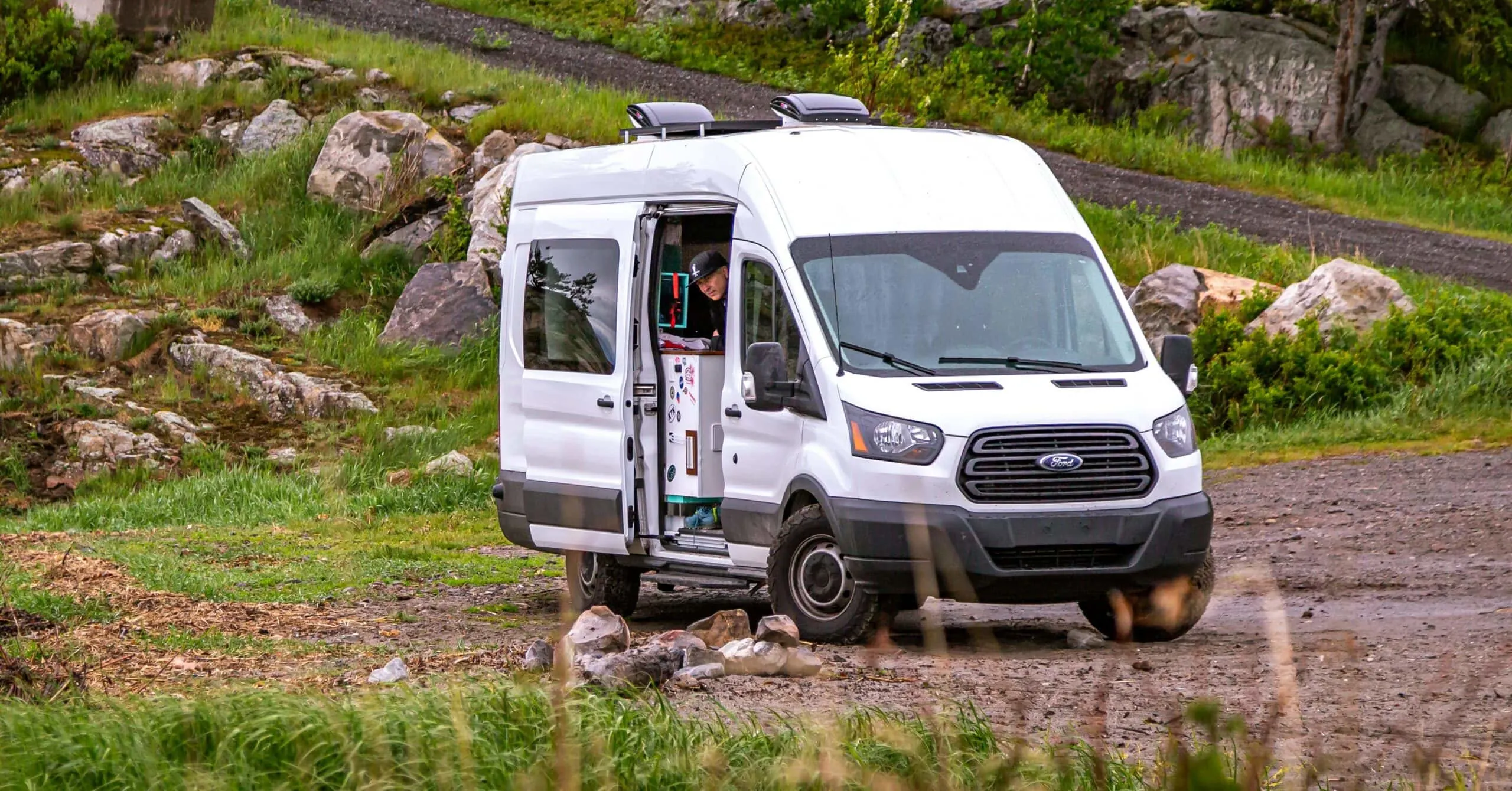
A Class B RV is the smallest of all classes of motorhomes.
It may be important to note that while Class B rigs usually offer some type of bathroom, they do vary in size and type. Some Class B RVs offer wet baths as opposed to dry baths, and some offer cassette toilets as opposed to gravity toilets plumbed to a black tank.
We spent about a month in a Class B campervan traveling in Australia. It was a bit tight (and had a wet bath), but it worked out fine for our short visit. We know that there are lots of people who full-time in them, and our hats are off to those minimalists! Watch our Class B campervan tour here.
For more information on dry baths vs. wet baths, we invite you to see our posts, “What Is a Dry Bath in a Camper?” and “Do RV Wet Baths Suck?”
Along the lines of the Class B RV but offering more living space (in some cases, significantly more), are the Class B+ RVs. We’ve traveled in Class B+ rigs in Europe (both Italy and England) and New Zealand, and really enjoyed our travels, though we missed the space to which we’ve become accustomed in our Class A. But it was only for about a month at a time, so we weren’t looking to full-time in one.
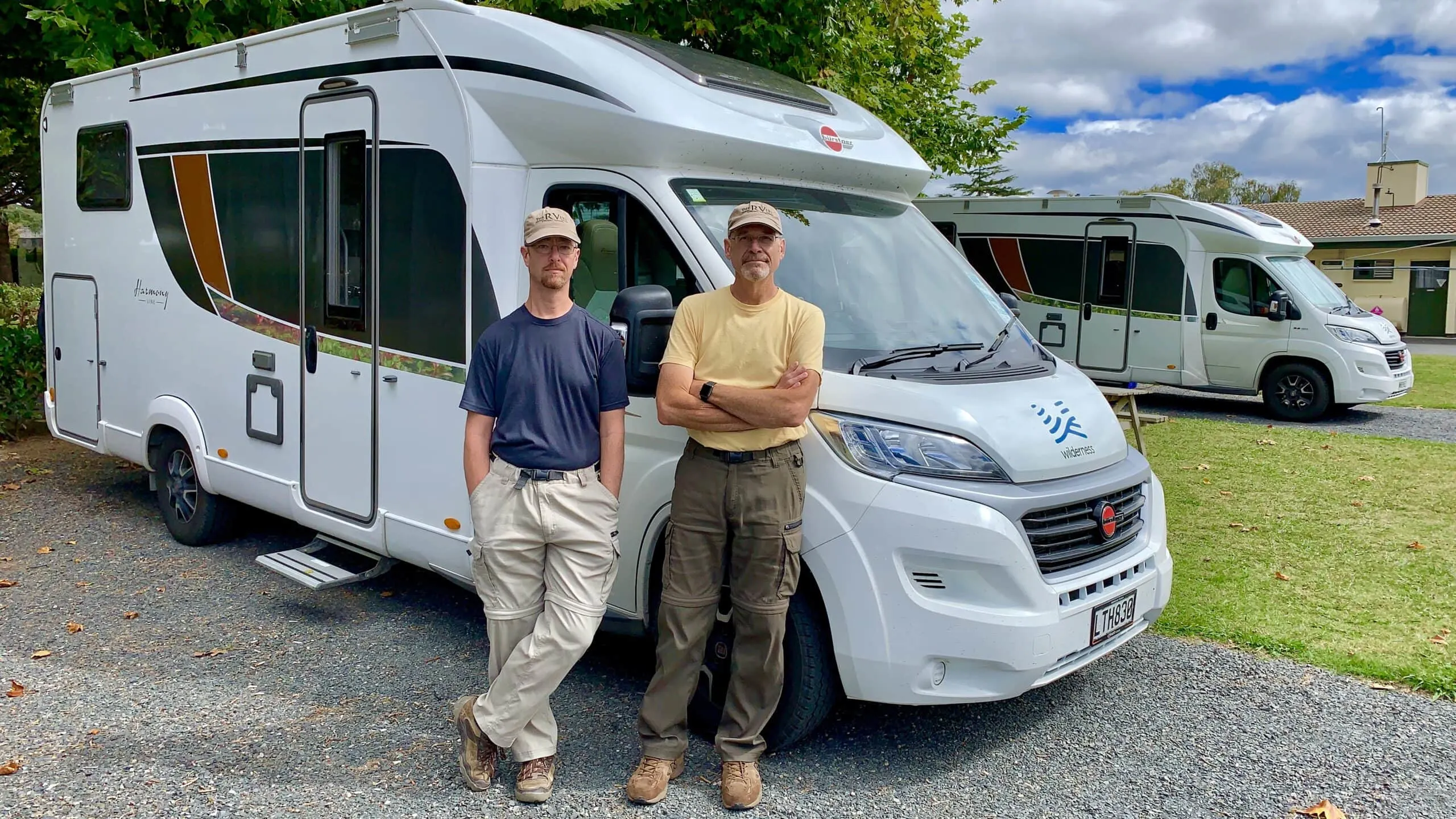
A Class B Plus RV, like this one that we rented when traveling in New Zealand, is larger than a Class B but not as large as a Class C RV.
For more information about the Class B+ RV, feel free to take a look at our post, “What Is a Class B Plus RV?” You can also watch our tours of various Class B+ motorhomes we’ve rented over the years to get a feel for what they’re like:
- Italian Class B+ RV – Exterior tour
- Italian Class B+ RV – Interior tour
- English Class B+ RV tour
- New Zealand Class B+ RV tour
Class C
The Class C RV is actually the middle child of the motorhome world. Sitting squarely between the Class A and B in size, a Class C RV offers more living space than a Class B, but not as much as a Class A.
You can often tell a Class C rig by the overhang that sits up above the driver’s area. A Class C RV by definition is built with a cab or cutaway chassis. So, the front takes on the appearance of a van while the house offers more living space and more storage.
Class C RVs vary significantly in size within the classification, running anywhere from 21 feet to 41 feet in length. So, a Class C can offer as much (or more) living space than some Class A motorhomes, but the space is laid out differently and the cab is very different by design. They also offer a different driving experience, so as always it’s critical to drive any RV you’re considering buying to see where you feel most comfortable.
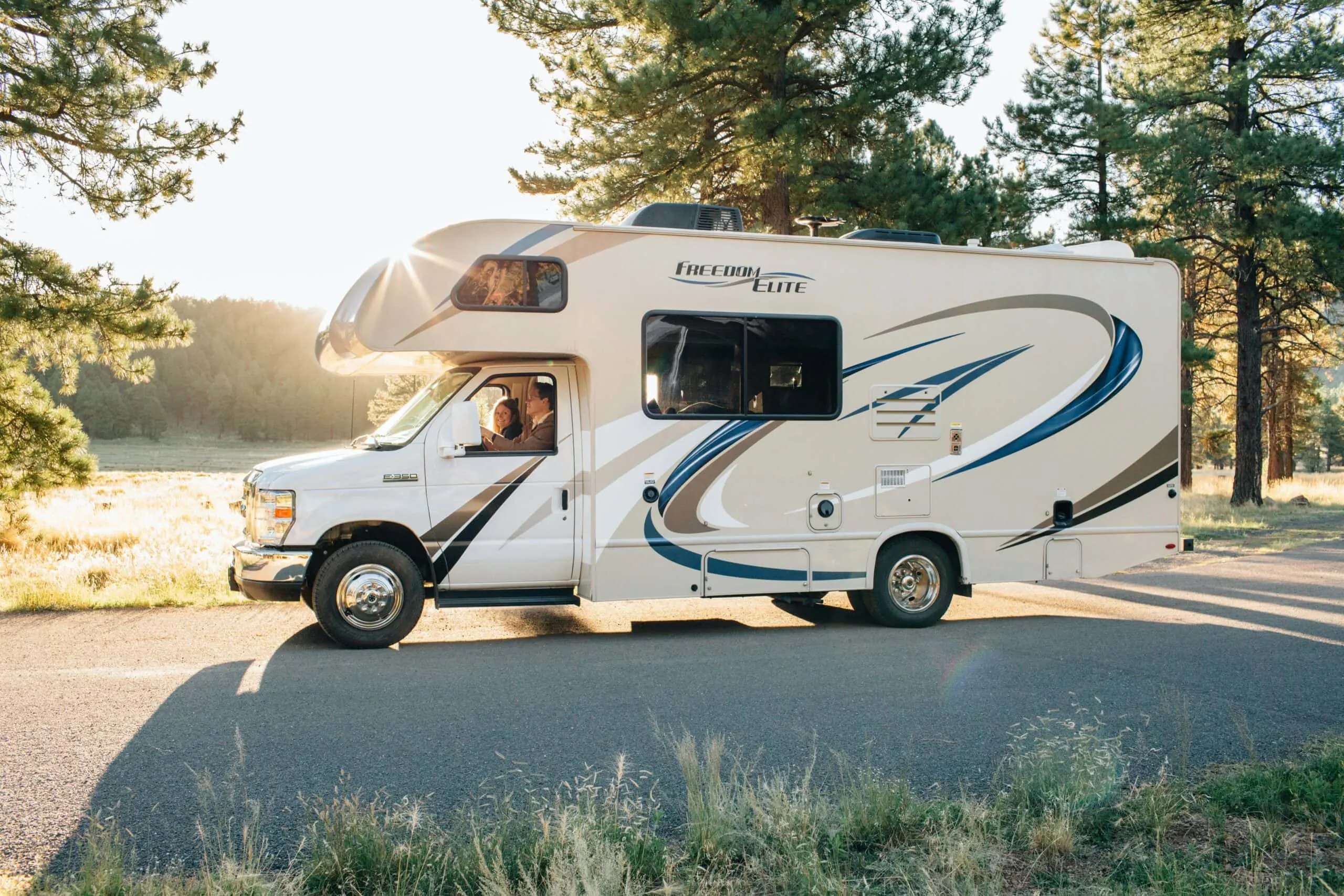
The overhang above the cab is characteristic of Class C RVs which are built with a cab or cutaway chassis.
Travel Trailer
Since they have no drivetrain, travel trailers are very different from motorhomes in terms of how they move from place to place. With a travel trailer, you’ll need an appropriate tow vehicle, capable of hauling your travel trailer and everything in it (along with your passengers).
Weight, both the amount and the distribution thereof, is critical when you’re towing a travel trailer. Be sure to learn everything you possibly can about safe towing prior to committing to buying any size travel trailer, or deciding what vehicle to tow it with.
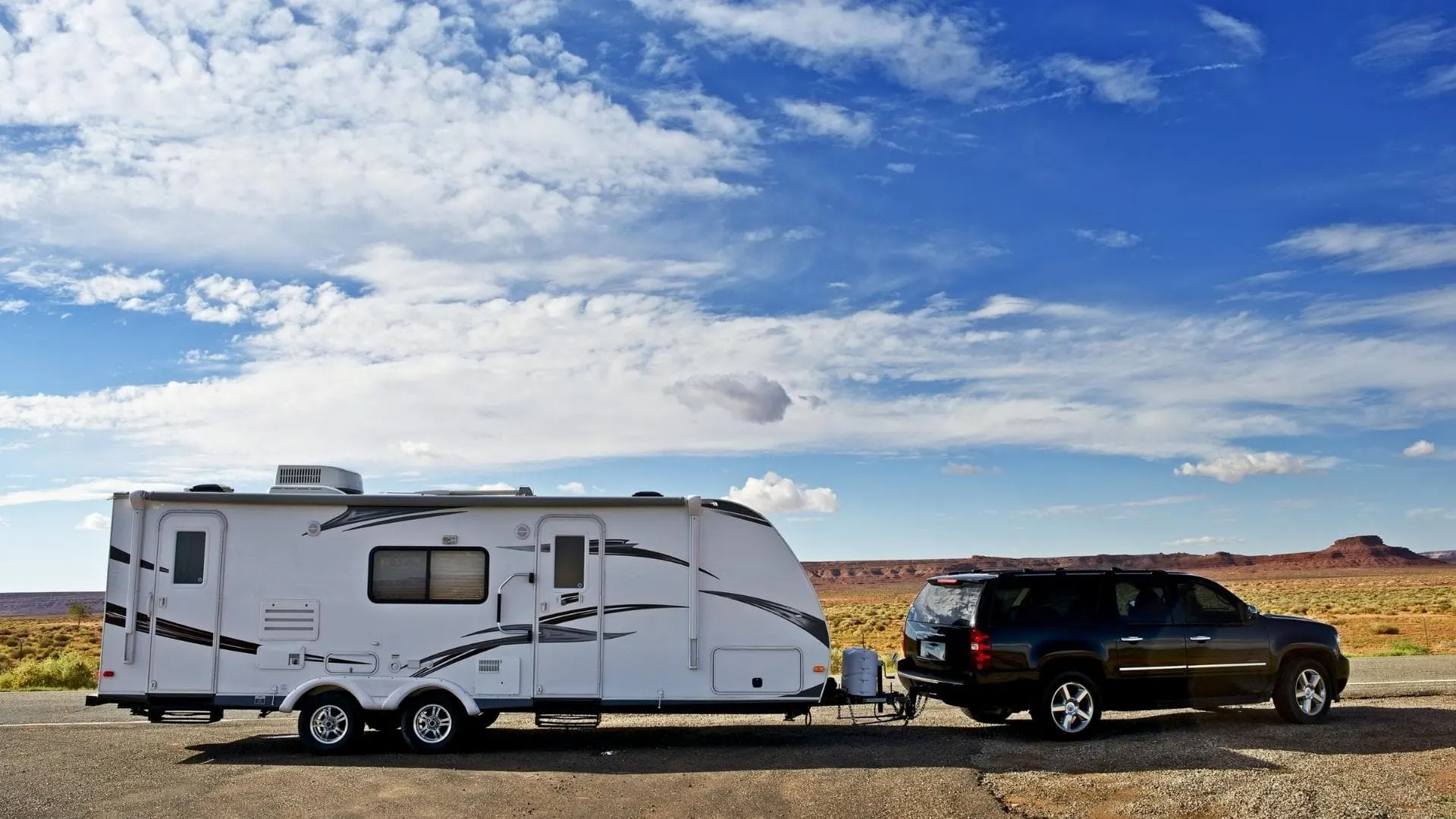
Travel trailers come in a wide variety of designs, sizes, styles, and weights.
Trailer sway is a real risk and can be avoided, but only if you understand HOW to avoid it. Please visit our post, “Methods For Trailer Sway Control” for more information on how to safely tow a travel trailer.
Travel trailers vary greatly in both size and amenities offered. There are many affordable travel trailers on the market as well as many expensive ones, so the market runs the gamut.
From tiny teardrop trailers to very large family-friendly rigs, there are so many options available to you, depending on the size rig you require, the amenities you desire, and your tow vehicle.
There are some travel trailers that are light enough to be towed with cars, minivans, and SUVs, while others require heavy-duty trucks to tow. No matter what size travel trailer you’re considering, be sure to take the time to learn your weight limitations and how to prevent and control trailer sway. (Yep – it’s important enough to say it twice!)
5th Wheel
A 5th wheel can offer the same size living space (or even more) and similar amenities to large motorhomes, but these towables are constructed differently. A 5th wheel has a raised forward section that offers a bi-level floor plan, and also requires a different type of hitch… and a pick-up truck.
While a regular travel trailer is generally towed using a standard hitch ball, a 5th wheel uses a jaw-type hitch to connect to the bed of a pick-up truck. (And yes, again, you absolutely need a pickup truck to tow a 5th wheel… usually a very robust one). So, 5th wheels hitch into a special attachment in the bed of the truck, as opposed to connecting to the rear of the tow vehicle.
5th wheels are incredibly spacious and can actually be easier to tow than might be expected. That’s because the weight of a 5th wheel is better managed by the truck due to the way its connection point sits in the bed, with the weight more centered over the truck’s chassis.
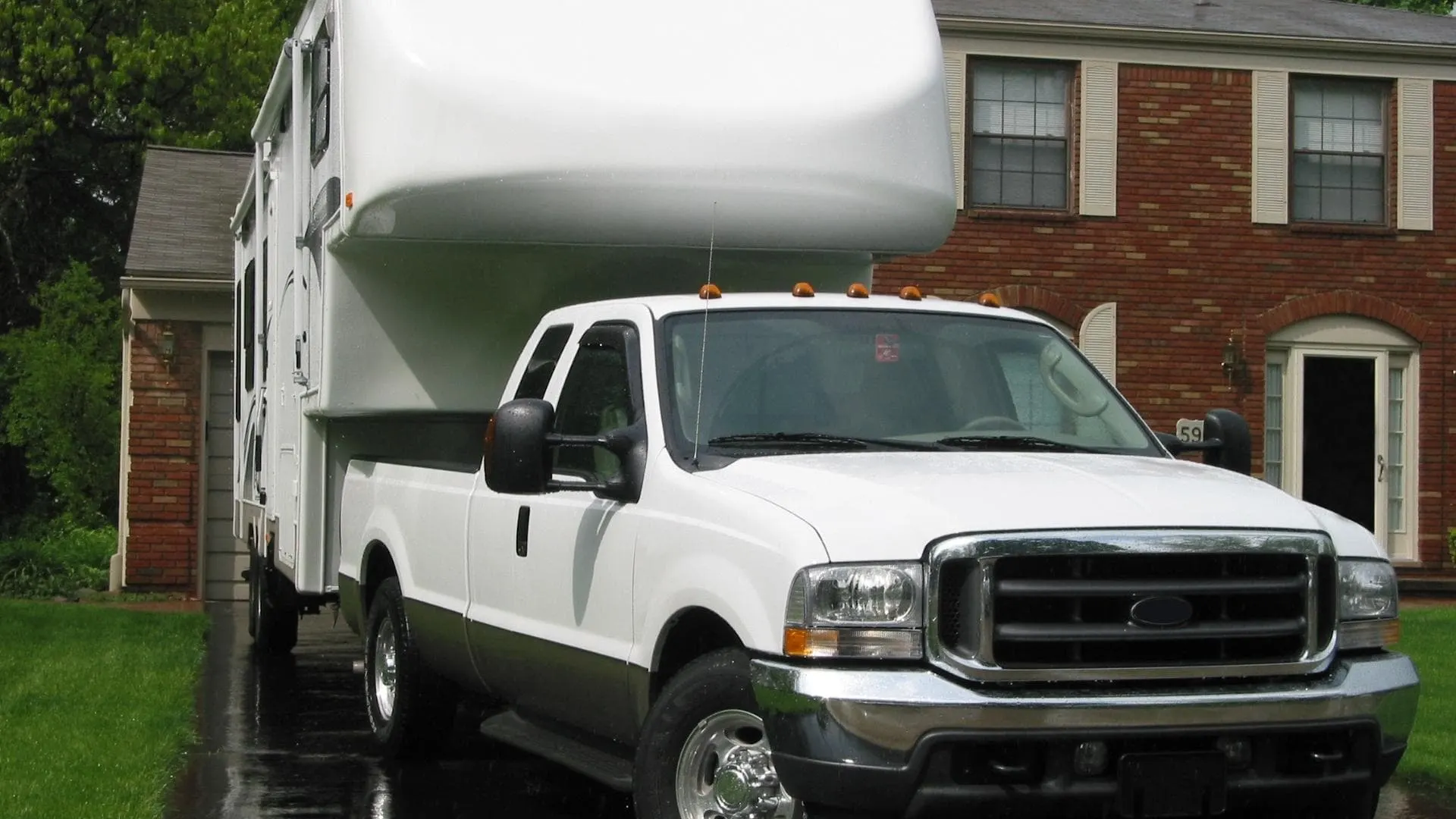
The raised forward section above the bed of the truck is characteristic of a 5th wheel. A 5th wheel needs to be towed by a substantial truck like the Ford F350 shown here.
The hitch of a 5th wheel generally connects right over the axle, so the weight of the hitch lines up with the rear wheels of the truck. So, while they may be very large, 5th wheels offer a more stable towing experience than most types of travel trailers.
5th wheels offer a wide variety of floor plans, most often with at least one or two slides, and some with four or more. They’re usually quite large, heavy rigs, which means that you’ll need a very substantial truck to tow a 5th wheel, and your fuel mileage will take a hit.
Expense is a significant consideration where a 5th wheel is concerned. Not only are they the most expensive towable RV, but the price you’ll pay for a truck that’s capable of towing a large 5th wheel can be substantial. When you add the cost of the truck and the cost of the 5th wheel itself, you can be looking at a lot of cash.
But like other towable RVs, 5th wheels lack a drivetrain. That almost always makes the RV itself less expensive than a motorhome.
All this may explain why 5th wheels are so popular for many long-term or full-time travelers. The cost of a 5th wheel and the truck with which to tow it may not match up with the needs of RVers who like to take an occasional camping trip during the summer months.
Toy Hauler
Toy haulers are also heavy, requiring a substantial tow vehicle – most often a pick-up truck. Available as both travel trailers or 5th wheels (and even a few motorhome floorplans), they’re different in that they have a “garage” in the back. The primary purpose, of course, is for hauling “toys” such as ATVs, motorcycles, bikes, kayaks, and any other type of recreational gear a person might want to have access to while traveling and camping. Some toy haulers can even carry a lightweight, compact car.
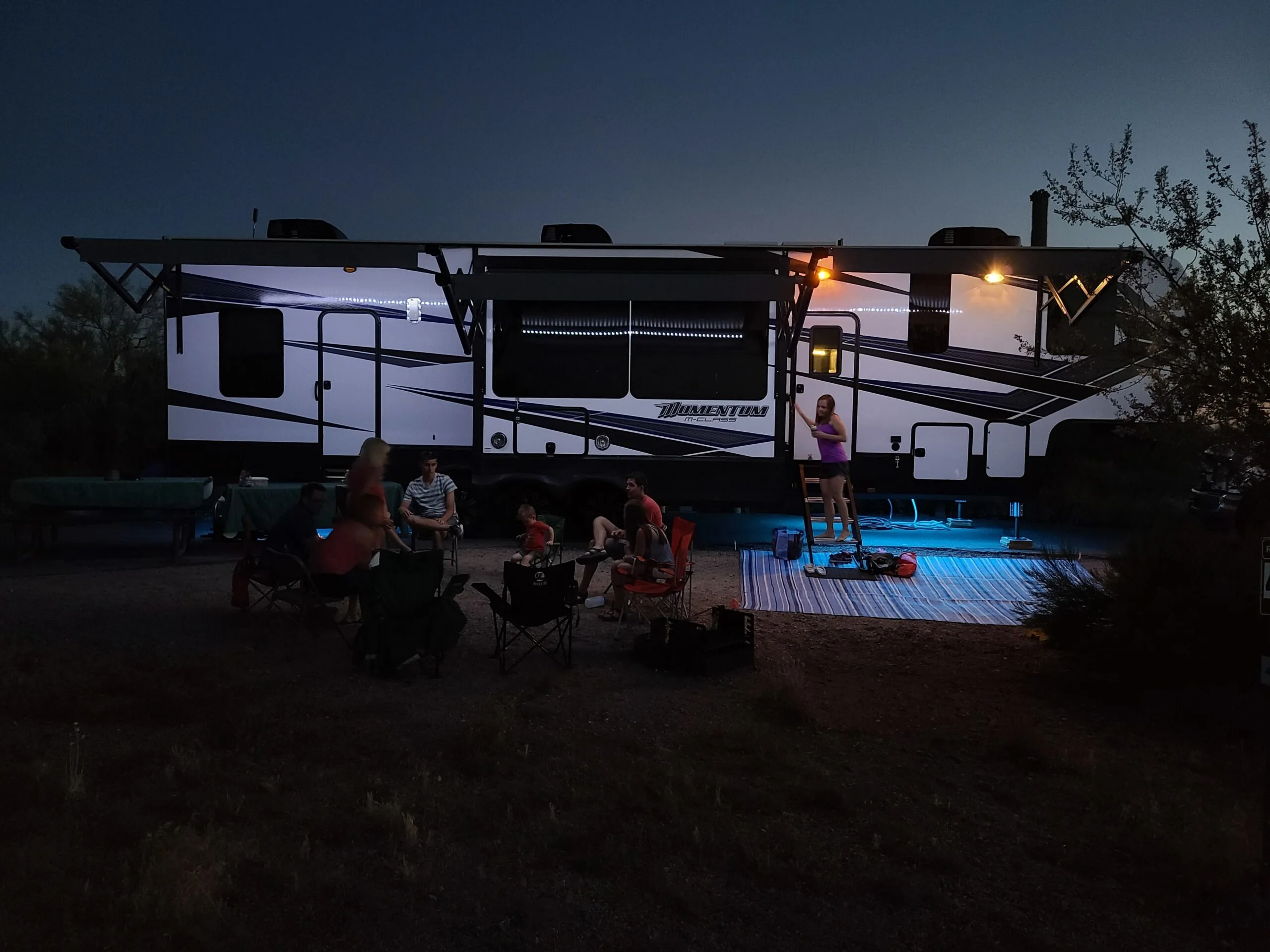
A toy hauler is a travel trailer that has a garage at the rear of the rig for carrying anything from ATVs to golf carts to motorcycles to other types of recreational gear…or even a small car.
The rear end of a toy hauler has a large garage door that opens wide, and a ramp for getting whatever you’re hauling into and out of the back of the rig.
Some travelers use the “garage” portion of their toy hauler as a mobile office or a private bedroom, so the garage space can be quite versatile. And toy haulers come in a wide variety of shapes and sizes, so if a garage is what you need for any reason, a toy hauler may be for you.
Retro Camper “Fixer Upper”
Another option that’s become quite popular in the past few years is buying an old “retro” camper and remodeling it. If you can find an older rig with good bones (chassis & structure), and no water damage, creating your own unique space by recreating the RV can be a lot of fun. It can also potentially save a lot of money depending on the amount of work that needs to be done.
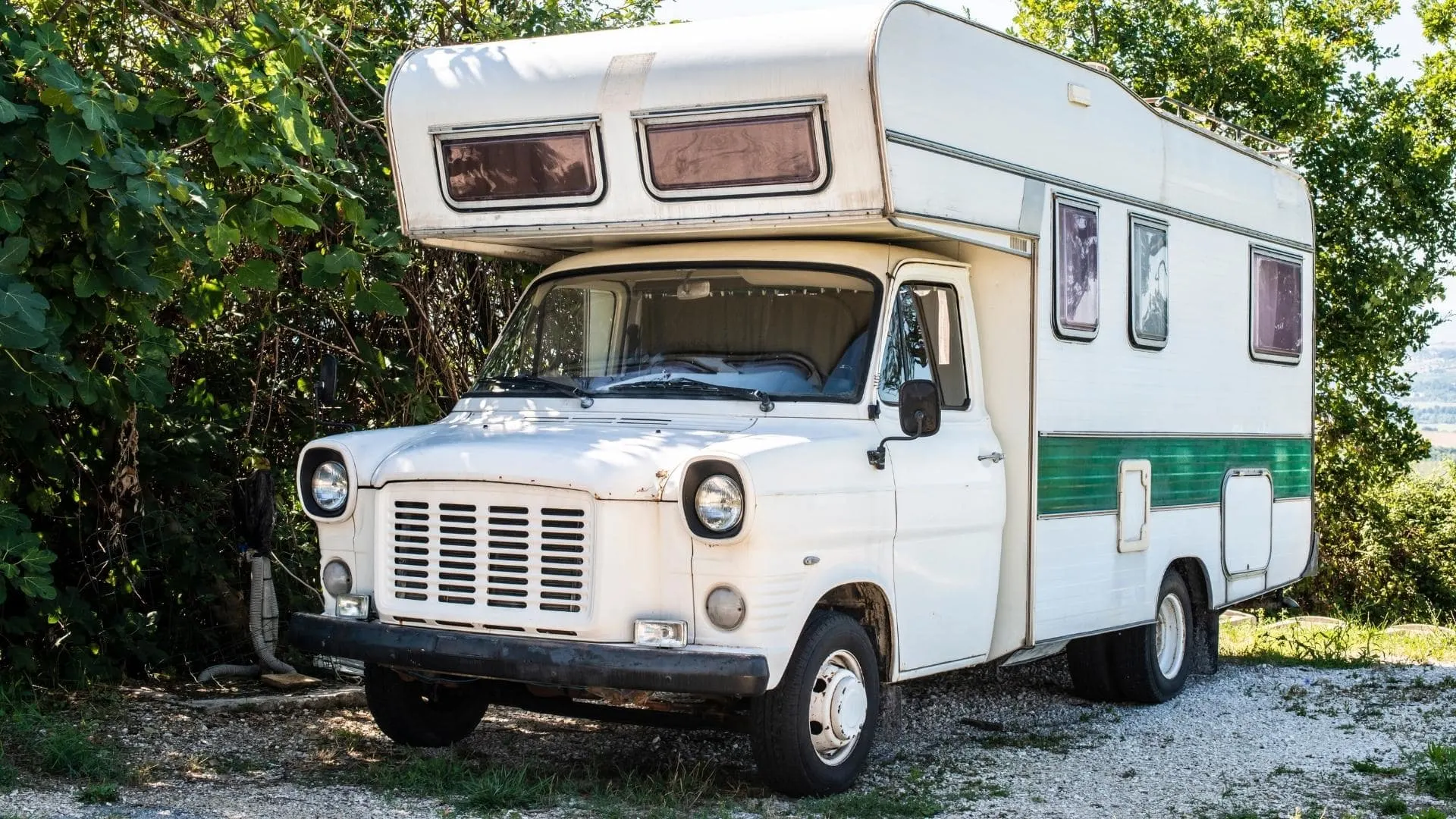
Many people find vintage motorhomes or campers in decent condition and renovate them to give them new life.
We’ve seen some really fantastic fixer-uppers, and the sky’s the limit in terms of personalization and creativity.
For more information on buying a “fixer-upper”, please see our post, “Buying a Fixer-Upper RV? 15 Things to Look For”.
Will You Buy New or Used?
Once you’ve determined the type of RV that best suits your family and style of travel, you’ll need to determine whether you want to buy new or used. This is a decision filled with pros and cons on both sides of the equation, but your personal situation is the only thing that can really determine the best option for you.
Feel free to check out our post, “Should You Buy a New or Used RV?” for details about the many considerations that need to be made when determining whether to buy new or used.
And again, if you find yourself in the market for a used Class A RV in particular, have a look at our article on “The Best Places to Buy a Used Class A RV”.
Determine Your Price Range
Regardless of the type of RV you’re interested in, and whether you prefer to buy new or used, you’ll need to spend some time determining your price range before you start shopping.
A price range is just that – a range of prices that you can afford. We suggest not looking too far outside of that range once you’ve determined what you’re comfortable with, because you’ll waste a lot of time looking at rigs that are unaffordable. And as of this writing, the RV market is red hot, so negotiating prices down very much is less likely.
Sit down and take a realistic look at your finances, your travel budget, and all of the ancillary costs associated with the purchase of an RV (see the section below on “Expenses You Need to Consider”), determine a realistic, comfortable price range, and start shopping.
How Will You Pay For the RV?
As you look at your finances and determine your price range, carefully consider how you’ll pay for the RV. Will you be seeking financing? Can you pay cash? These things are important to determine in advance and can be helpful in price negotiations.
If you’re planning to pay cash, and have the budget to buy your chosen type of rig, you’ll be all set once you find the right one. But financing for anything other than a new RV may be more difficult to come by. Plan ahead for the money part of the equation, and happy RV hunting will follow!
What Type of Traveling Will You Do?
The type of traveling you intend to do with your new-to-you RV is a key consideration. Look carefully and realistically at your travel intentions prior to determining the type of RV you’ll be shopping for, because different types of RVs lend themselves best to different types of travel. Let’s take a look!
Full Time
If you’re going to be living in your RV full time, there are a number of amenities you’ll want to be sure to have, including sufficient living space, a comfortable bathroom, and plenty of storage.
Additionally, you’ll need to consider your lifestyle and what you like to do. If you love to cook or bake, for example, you may want an oven or even a residential refrigerator. Some people (like us!) want a washer and dryer on board, while others are satisfied with a trip to a laundromat every week or two. Some RVers, especially full-timers, appreciate the luxury of a dishwasher. (Yes we have one… and no, we’re not talking about John!) ????
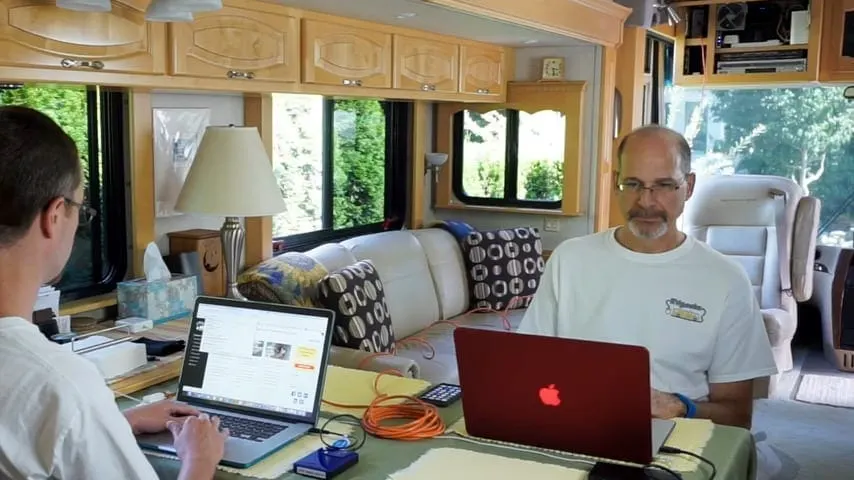
If you’re going to work full-time from your RV as we do, you’ll want sufficient space in the RV to have a comfortable workspace.
If you’ll be working or running a business from your RV, as we do, you’ll want a comfortable workspace and certain amenities that enable the technology you’ll need, possibly including a consistently reliable mobile connection to the internet.
If you’ll be boondocking off the grid for extended periods, you’ll want holding tanks that are large enough to meet your needs. You may also want a large solar or battery bank. Of course, many of these types of things can be added afterward to almost any RV.
If you choose to go with a motorhome, especially a larger one, you may want to tow a vehicle behind your RV. This will give you the ability to travel to trailheads, stores, restaurants, movie theaters, concerts, etc., without trying to navigate city streets in a large RV… or having to break camp every time you want to explore locally.
If you’ll be living full time in your RV, with or without a family, there are a number of things to consider. We suggest focusing on how you’re most comfortable – living and traveling – and taking it from there.
Part-Time
If you’ll be traveling part-time, where will you travel and what amenities will you desire as you do so?
Will you almost always be connected to shore power, water, and sewer at campgrounds and RV parks? Will you need solar power or a generator? How large will your holding tanks for fresh water, gray water, and black water need to be for your style of part-time travel?
Once you’ve determined what you’ll need to be comfortable as a part-time RVer based on the type and amount of travel you intend to pursue, you’ll have a clearer vision of the type of RV that will best suit your needs. You’ll also have a better idea of what amenities are important to you.
Weekend-Vacation Travelers
Many RVers enjoy camping during summer weekends and possibly a couple of additional weeks during the year when family members can take a vacation from work and/or school.
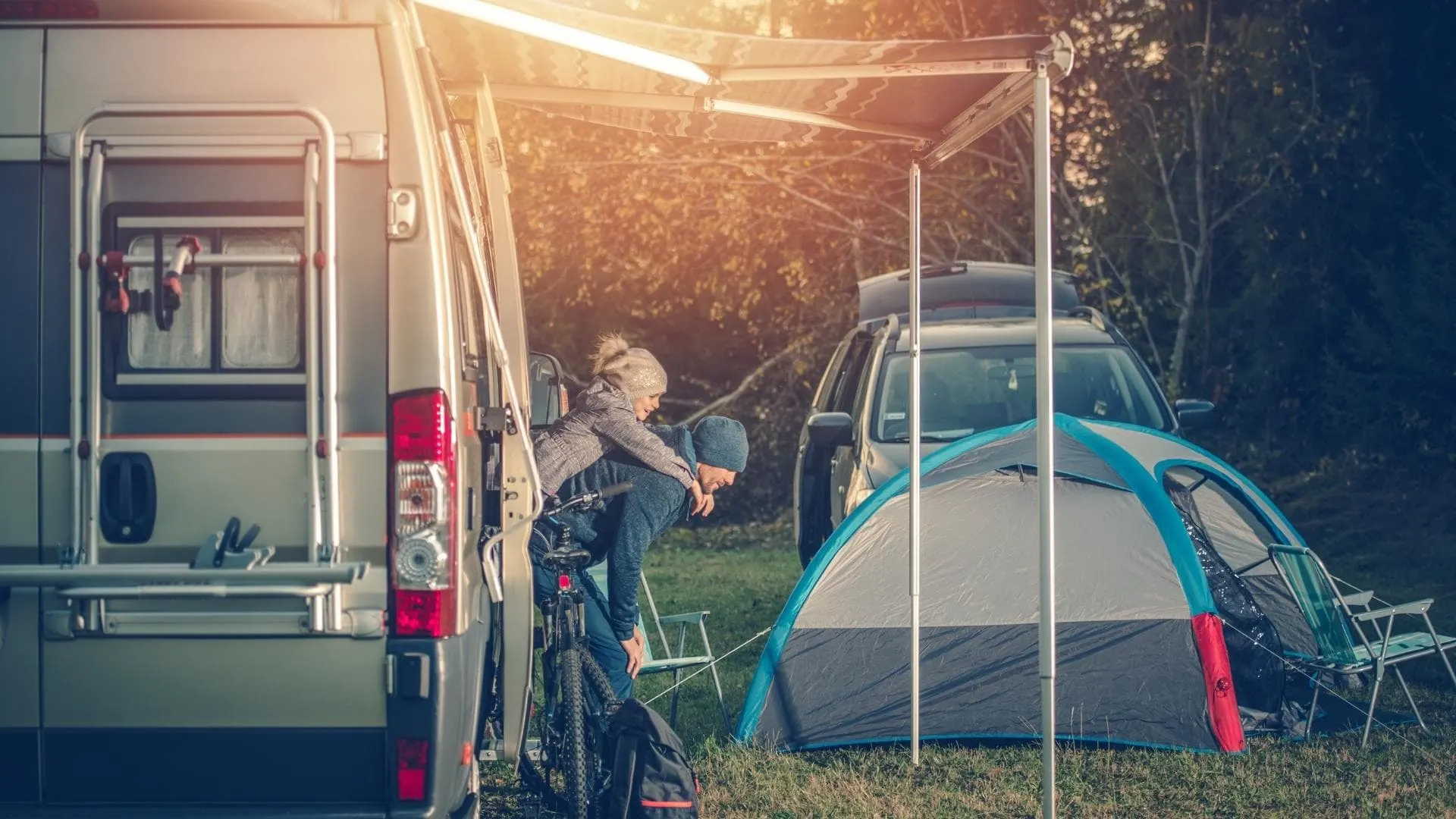
If you’ll be camping occasionally, perhaps on summer weekends or school vacations, this may also influence the type of RV you need.
Some weekend travelers don’t really venture too far from home, preferring to visit campgrounds and state or national parks in their own immediate area.
Other travelers prefer to roam far and wide to see what distant states have to offer.
Still, other summer RVers use their campers once or twice a year to get together camping with family and friends, treating their rigs like a summer camp, which is also great.
There are so many ways to enjoy an RV. Keeping in mind your preferred way to travel in the near future is a good place to start when planning to buy an RV.
Destination Travelers/Family Visitors
Are you retired and your children are spread all over the country? Many retirees enjoy traveling, and some travel from offspring to offspring, carrying their own home-on-wheels with them. This way they have everything they need to live comfortably as they travel and while they’re visiting family.
Some people buy RVs to get from point A to point B and back. There are many “snowbirds” who do this. They may use their rig to travel from Maine to Florida where they’ll stay for the winter, for example, and then as spring turns the corner they drive back north to spend the summer in a northern climate.
Some snowbirds live in their RVs when they reach their destinations, and others own a smaller RV for the purpose of getting to and from their destinations where they stay in a “sticks & bricks” house instead.
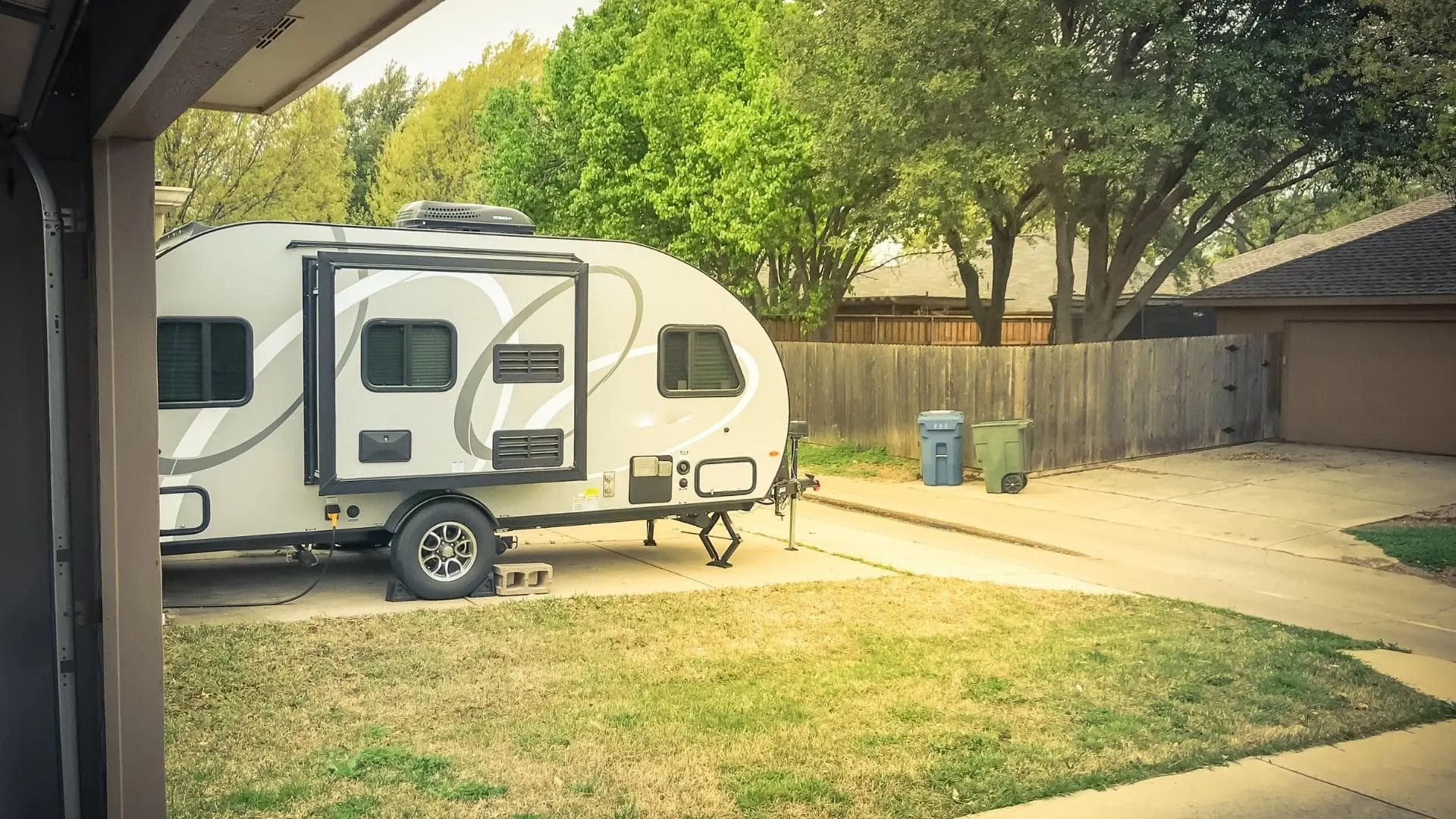
Many people use their RVs to visit family and friends. This way they can have the amenities of a home-on-wheels as they travel, and they’ll have their own personal hotel while they’re visiting.
If you’ll be using your rig to move comfortably from point A to point B and back, a Class B RV may be just the ticket for you. You’ll have a place to sleep, a fridge and a way to cook meals on the road, sufficient storage for the trip, and your own bathroom as you travel. It can also act as a fine around-town vehicle while you’re at your destination.
If, however, you’ll be living in your RV once you reach your destination, you may want to opt for a rig with more living space and more comfort overall.
Cross-Country Travel
If you intend to skew toward long-distance travel, you’ll probably want to consider the cost of fuel. That may mean moving fuel mileage higher up on your list of considerations when buying an RV. This, of course, depends largely on who will be traveling with you and how much space you need.
It’s also important to determine where you’ll be traveling. Will you be driving high into the mountains? Off-road at times? What kind of cross-country travel will you pursue?
If you’re simply driving from coast to coast, you may consider one type of rig. But if you’ll be taking lots of side-trips up mountain passes, spending time camping on beaches, etc., you’ll want to take all of this into consideration as well.
National Park Visitors
Nearly 98% of National Park campgrounds can accommodate RVs that are 19 feet long or less, and up to 90% permit rigs up to 25 feet in length.
On average, most of the National Parks will offer entry to RVs with a maximum length of 27 feet.
If you’re buying an RV with visits to amazing national parks high on your list. You may want to skew smaller. That’s especially if you intend to stay in their campgrounds. You’ll want to consider the length of your RV as an important factor.
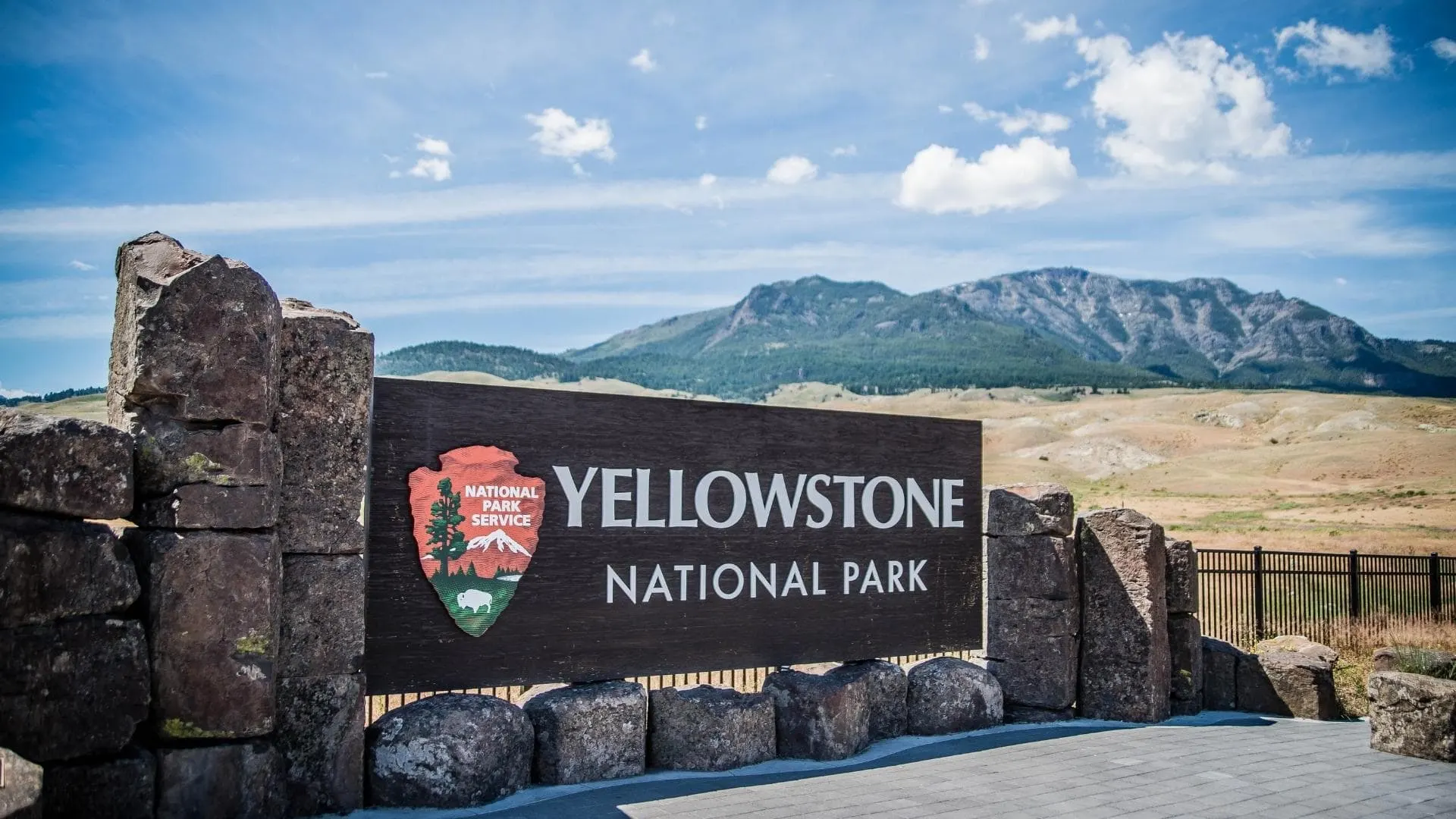
If you’re planning to visit many of the national parks and hope to stay in their campgrounds, you’ll want to know the RV size limitations for the parks and campgrounds you’re planning to visit.
Different campgrounds within the same national park may accommodate different-sized rigs as well. Just as an example, there are a number of campgrounds within Yellowstone National Park. While Yellowstone’s Canyon campground permits an RV length (motorhome OR vehicle+trailer) of 40 feet, Indian Creek has 35 campsites that accommodate up to a 30-foot rig and 10 campsites that will accommodate up to a 35-foot rig.
So, it’s wise to consider in advance what your national park travel desires are and where you intend to park or camp and keep all of that in mind when RV shopping. Luckily, you can do a ton of national park research all in one place: https://www.nps.gov
Will You Be On the Grid, Off the Grid, Or Both?
This is an important question to ask yourself ahead of buying an RV because boondocking requires some considerations you won’t need to make if you intend to always be connected to shore power, city water, and sewer.
If you know for sure that you’ll always opt to pay to stay overnight in campgrounds and RV parks with full hookups, then you really don’t need to invest your money in a solar system, for example. You also won’t need very large holding tanks for your fresh, gray, and black water.
However, if you think you might be more of a boondocker at heart (as we are), then you’ll want solar and battery systems that allow you to harness the awesome power of the sun. You’ll also want holding tanks that are large enough to allow you to stay out for the intended length of time you like to camp are well worth considering.
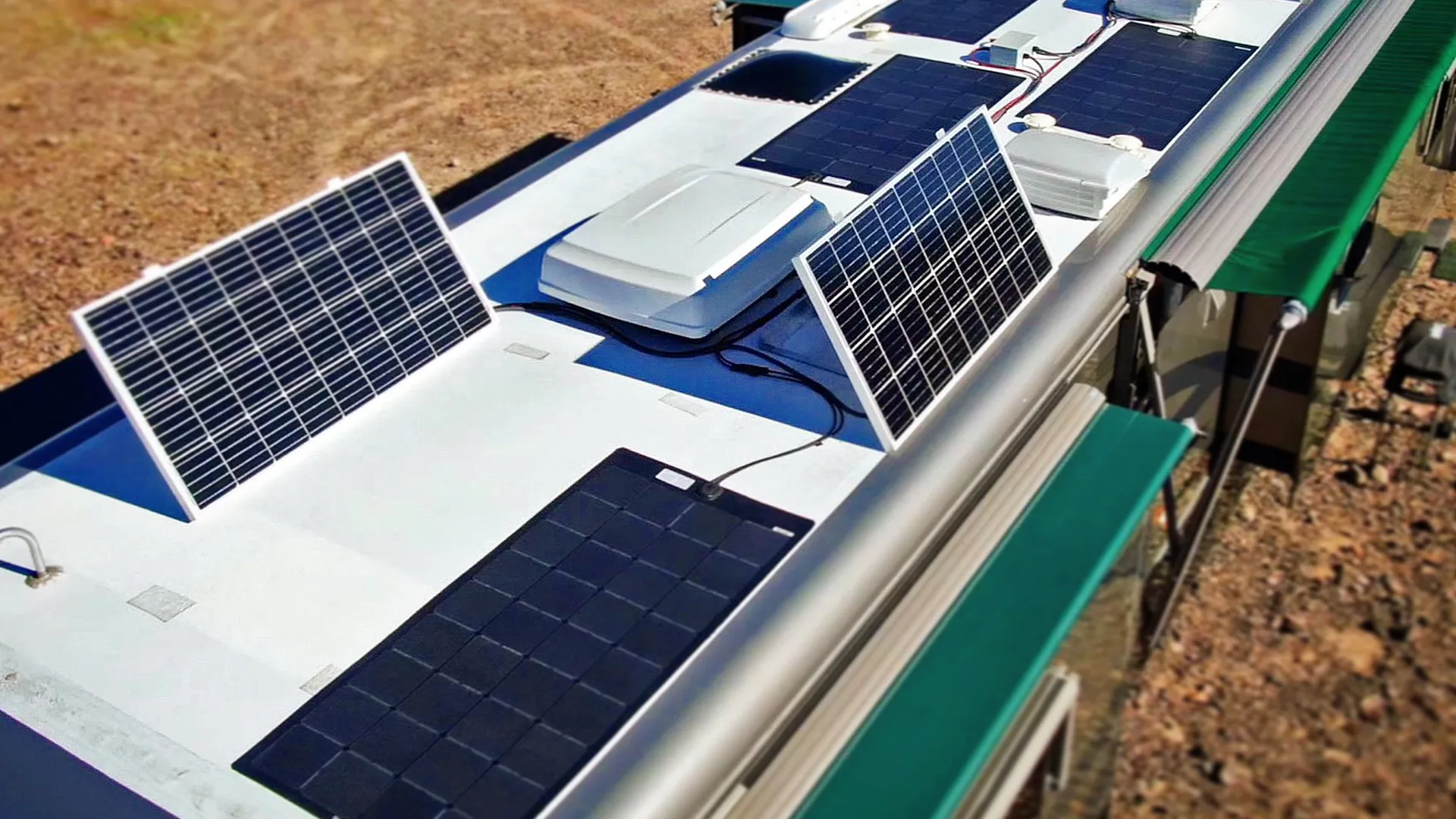
If you intend to largely boondock for long periods as we do, you may want to invest in a solar system that feeds your electrical needs. On the other hand, if you intend to be hooked up at campgrounds whenever you use your RV, solar wouldn’t be a worthwhile investment for you.
As mentioned, solar and battery banks can be added to most RVs. But holding tanks are another matter. It’s probably impractical to swap those out!
If you’re not familiar with boondocking, we encourage you to give it a try. It’s far and away the best way to take full advantage of all that nature (and RVs) have to offer.
If you’re used to being hooked up at campgrounds but would like to try boondocking, we have ideas, guidance, and recommendations for you in our post, “RV Boondocking Making You Nervous? Try this!”
For those of you who are ready to give boondocking a try, here are our “11 Best Ways to Find RV Boondocking Spots”.
And for anyone who might be interested, here again is our “Complete Guide to Class A RV Boondocking”. No matter what size or type of RV you have or intend to purchase, you’ll find some helpful tips there, based on our nearly two decades of experience.
What Features Are Important to You?
Before you set out to buy an RV, write down the features and amenities that are most important to you and your family. If possible, try not to settle where your most important amenities are concerned. There are many RVs on the market – used and new – and you should be able to find what you’re looking for in your price range.
We already mentioned wet baths vs. dry baths earlier in this post, but this is a great example of a feature you should decide on before shopping for an RV. And if you decide that a wet bath is just not something you’d like to contend with in your travels, then don’t look at rigs with wet baths. On the other hand, if the type of bathroom is unimportant to you, then don’t place those limitations on yourself.
Whatever is important to you and your family as you travel, prioritize those things on your list, and focus in your search on RVs that offer those amenities.
Expenses You Need to Consider
When you’re buying an RV, there are a number of associated costs to prepare for in addition to the purchase price.
Sales Tax
If you’re a resident of a state that has a sales tax, no matter where you buy your RV, you’ll have to pay the sales tax in your state of residence.
When you’re considering a major purchase like an RV, sales tax can be considerable. For example, if you live in a state with 6% sales tax and you buy a $75,000 RV, your sales tax will be $4,500. That’s a sizeable chunk of change, so be prepared in advance to deal with sales tax.
Excise Tax
Likewise, depending on the year and MSRP (manufacturer’s suggested retail price) of your RV, and depending on your state of residence and the rate imposed, an excise tax may be an annual cost for which you’ll need to be prepared.
Excise taxes are levied by federal, state, and local governments, but aren’t uniform throughout the United States. Excise tax is a tax levied annually for the privilege of operating a motor vehicle, motorhome, or towed camper trailer on public ways.
Excise taxes are payable annually at the time of registration of the RV.
Registration Fees
In every state in the United States, you’re required to register an RV before driving it on the public way. This is true whether you buy a motorhome, travel trailer, 5th wheel, toy hauler, or any type of camper.
You’ll pay the registration fee annually when you register your RV in your home state. These fees are higher in some states than they are in others.

When calculating your budget for buying an RV, be sure to include all of the extraneous expenses associated with the purchase and use of the RV.
When you’re looking at buying an RV and you’re planning your budget, be sure to include your RV insurance premiums. When you’re looking to buy a particular RV, you can contact your insurance agent for an idea of what it will cost to insure the rig.
We suggest that you make notes in advance of what you want to be covered in your RV insurance plan. Do you want windshield coverage, for example? Do you want your insurance company’s roadside assistance plan included? How about emergency coverage that includes hotel costs if you’re sidelined mid-trip? These are all questions to ask before you accept any insurance policy.
For more information, feel free to check out our post, “What Does RV Insurance Cover?”
Roadside Assistance Plan
There are many excellent independent roadside assistance plans to choose from if your insurance company doesn’t offer one to satisfy your needs.
Once again, decide what you want your plan to cover, and shop for a roadside assistance plan that offers the coverage you want.
Have a look at our post on the “Best RV Roadside Assistance Programs for Peace of Mind” for detailed information on what to look for as well as information on many of the top plans.
Cost of Campgrounds & RV Parks
When you’re creating your RVing budget, if you plan to stay at commercial campgrounds and RV parks, you’ll want to budget for those costs as well.
The cost for an overnight – or several – at various campgrounds and RV parks range widely from nominal to quite expensive. So, be sure to look into the type of RVing you intend to do, and try to figure out the number of nights you’ll be paying to stay at commercial locations.
Here you’ll also want to figure in any costs of annual memberships to programs like Harvest Hosts, Boondockers Welcome, Thousand Trails, Passport America, Escapees RV Club, etc.
Our post “How to Save Money on Campgrounds” may be helpful here.
Costs of Maintenance & Repairs
Factoring into your budget the costs of maintenance and repairs isn’t easy because you really never know when you’ll need a major repair. This is why it’s important to budget for general maintenance AND to have some money set aside for unanticipated repairs.
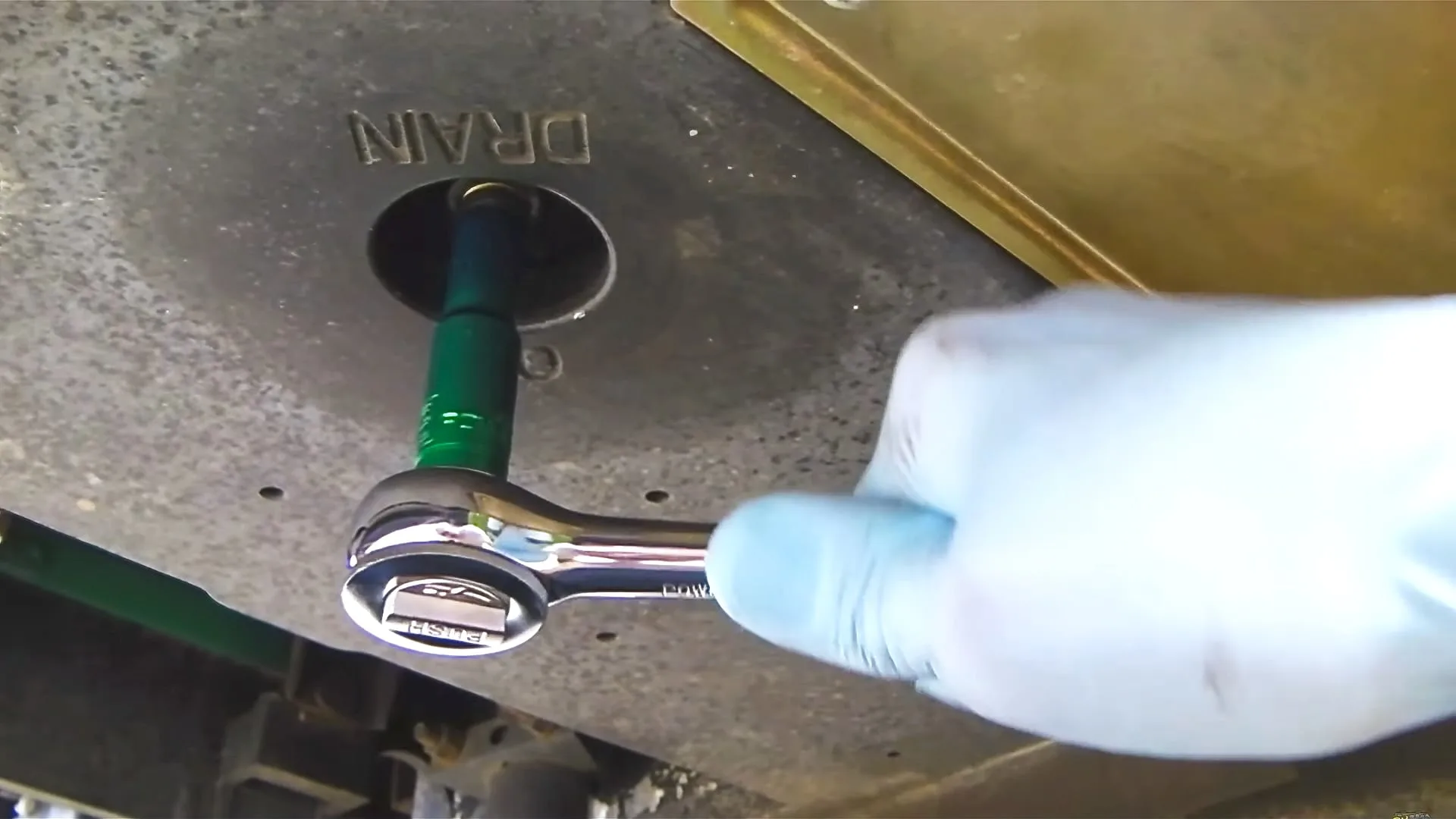
It’s difficult to predict future repairs, but you can plan for the costs of regular maintenance of your RV (and you can learn to do a lot of it yourself!), and then be sure to have an emergency fund for unanticipated repair costs.
There’s always something to repair or some maintenance that requires your attention on an RV. This is why we’re big on DIY maintenance and repairs to the greatest extent possible. Not only is it the best way to come to know your RV, but it saves a lot of money and inconvenience over time. It also keeps your rig out of repair shops! See our post “7 Reasons to Avoid RV Repair Shops” for details.
You may think you’re incapable of repairing and/or maintaining your own RV to a certain extent, but look at us! We’re just a couple of regular guys who learned as we went along, and now you know us as RVgeeks, a couple of RV DIYers!
To get you started, here are “7 Maintenance Tasks You Can Easily Do Yourself”.
Storage Fees
Will you be storing your RV for part of the year once you’ve purchased it? If you don’t use your RV year-round and don’t have a private area where you can store it, you may need to consider adding storage fees to your budget. These vary widely in terms of cost and amenities…from outside storage to storage facilities that are indoors, climate-controlled, and with security.
Feel free to have a look at “What Are the Best Motorhome Storage Options” for details.
Propane
If the RV you buy has a propane furnace and a propane stove, you’ll want to budget for propane costs as well. How much propane you use will largely depend on how much you travel and where (cold climate traveling?), as well as the efficiency of your RV’s propane use.
Fuel
The cost of fuel for your RV will vary based on the type of RV you buy, where you drive it, and how much you drive, of course.
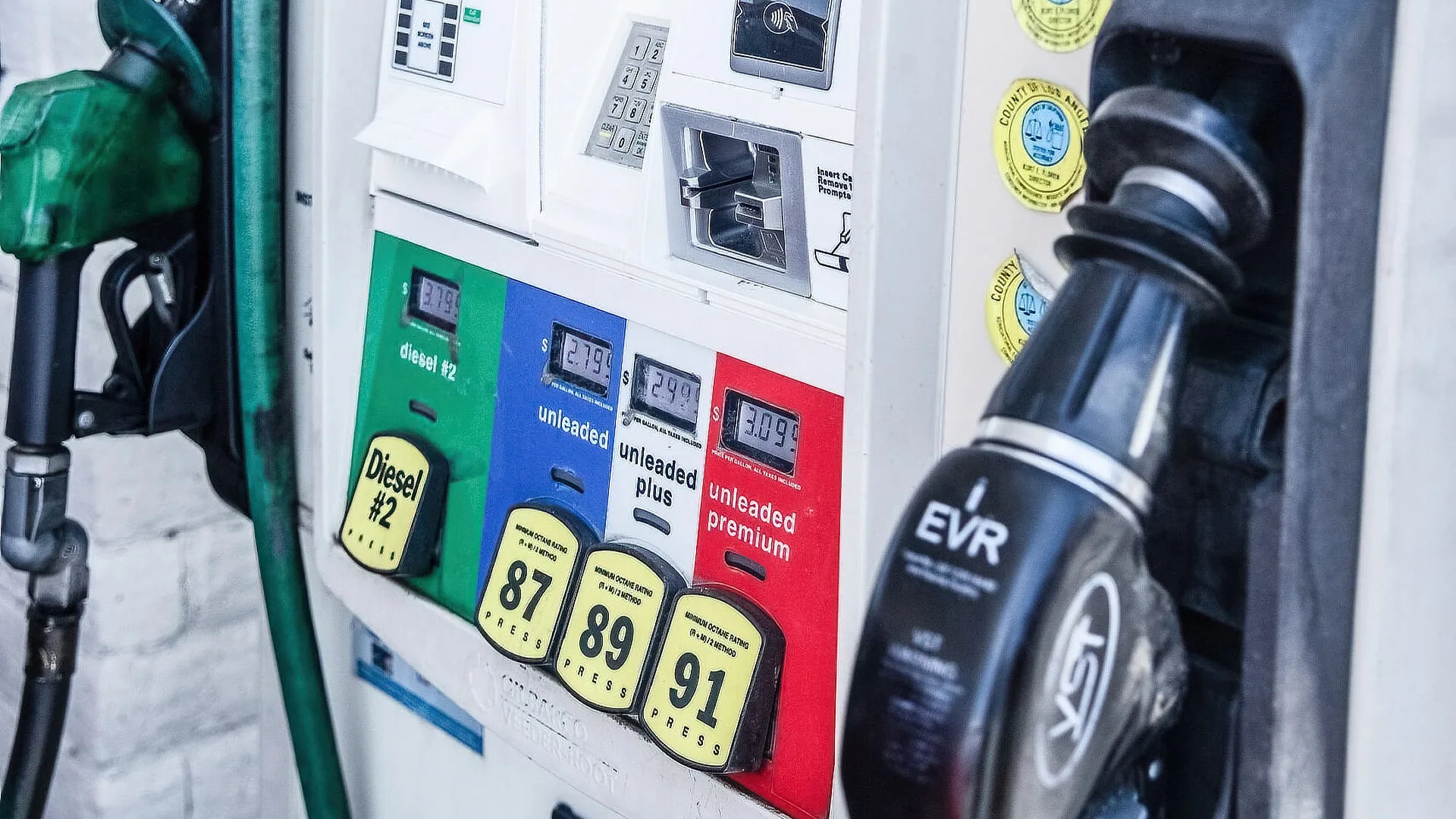
Budgeting for fuel costs can be difficult, but if you’re able to roughly calculate the distance you’ll be traveling, you’ll have a sense of what you’ll be spending on fuel. If you travel a lot, fuel may well be your most significant expense.
Class B motorhomes and small, lightweight travel trailers will be at the lower end of the spectrum, and Class A motorhomes and large 5th wheels and toy haulers towed by large trucks will be at the top of the bill in terms of fuel costs.
How to Score the Best Price
There are a number of ways to get the best possible price when you’re in the market for a new or used RV.
One way is to buy in the off-season. Everybody’s shopping for an RV in the spring. The daffodils are popping their heads up and everyone is thinking about summer. That’s when the market is flooded with buyers.
Whether you’re buying new or used, buying in the off-season is likely to get you the best price. Dealers are often anxious to move last year’s leftover models, and you can often score a better deal.
The same is true in the private market. Prices are usually higher and competition greater as the camping season is about to bloom. If you can buy an RV in mid-late fall, you’re likely to get a much better price. You may also find a lot of options in all the places where you’re looking!
Where to Look for an RV
The following are great places to search for a new or used RV:
- RVTrader
- Facebook Marketplace and Other Social Media Groups
- Craigslist (state-by-state search)
- Onecraigs (nationwide Craigslist search)
- Conversion Trader
- Local Dealerships
- Online Groups (dedicated to particular RVs)
You’ll find lots more information and guidance on buying a used RV, in particular, in our post “The Best Places to Buy a Used Class A RV”. This article’s value isn’t limited to Class A rigs, though, so be sure to give it a glance for details and additional guidance.
Geek Out with Us Every Week
Join our newsletter to learn about all things RV-related. Every week we offer free tips, tricks, product reviews, and more to our online community of RVers. So, whether this is your first time on the road or you’re a seasoned expert, we’d love for you to geek out with us!


Forrest Meckling
Wednesday 6th of March 2024
Excellent advice (information). One thing that I wish I had done when buying our last RV (5th wheel) was to sit on the toilet and see if you are comfortable getting your business done. I found our toilet area a little small. Also, although the 5th wheel handles great on the road, I personally found it a little difficult to back in compared to our previous trailer.
TheRVgeeks
Thursday 7th of March 2024
Good point, Forrest! It's easy to overlook how the "I-use-it-every-day" features of the RV will work for you... so checking the comfort of the space around the toilet is a great suggestion. As far as the difference between maneuvering a fifth wheel and a travel trailer... from what we've heard from other RVers we know with more experience in the towables world, that happens because of the difference in the mounting point. Moving that point so much further forward on a fifth wheel (moving it from behind the rear bumper up to above the rear axle) changes the geometry of how steering inputs on the towing vehicle affect the angle/movement of the trailer. Takes some getting used to when you switch between the two.
Rick Dowling
Wednesday 6th of March 2024
Another great article, thanks guys!
I still think the most important questions to answer before anything else is what are you getting the RV to do? Full or part time, where are you going (plugged in, off grid, mooch docking?), how often are you going there, how long are you staying in one place, what do you want to take with you(golf cart, motorcycle, boat?). Or even how many toilets do you need? TWO!! Questions like these can really lead to answers that will make a particular choice of RVs better suited to the actual use intended.
TheRVgeeks
Wednesday 6th of March 2024
Thanks Rick! All these considerations are exactly what helps lead to a great RVing experience. Can't wait to see how we've done with selecting our first new rig in almost 19 years. 🤞
Steve Zoller
Saturday 5th of March 2022
You did a very thorough review. Well done. There’s one important point I’d add. If you plan to travel with more than two people, you need to find a coach with forward facing seats with seat belts. Many, especially in smaller rigs, are side facing and just aren’t safe.
TheRVgeeks
Saturday 5th of March 2022
Great point, Steve! Thanks for adding that!
Gay Tacoma Washington
Saturday 5th of March 2022
While I'd love to buy a motorhome, I'm wondering what size I should get. As a newbie RVer, one who has never driven anything larger than a Chevy 1500 pickup truck, I neither need nor want anything that's 30' in length, 20' tall, or weighs 50k.
Rick Dowling
Wednesday 6th of March 2024
@Gay Tacoma Washington,
Good news! There are any 20’ tall RVs! 😬😊
TheRVgeeks
Saturday 5th of March 2022
We think you'd be surprised by how driveable a motorhome can be, Jason! You may want to try renting one (from RVnGO or RVshare or one of the other peer-to-peer RV rental marketplaces) so you could try it out. It's a balancing act: small & maneuverable means less space inside to be comfortable (which is great if you're more outdoorsy and only use the inside to sleep/shower/cook... while larger & less maneuverable means more space inside to be comfortable. LOL! Not a "one-size-fits-all" scenario at all!